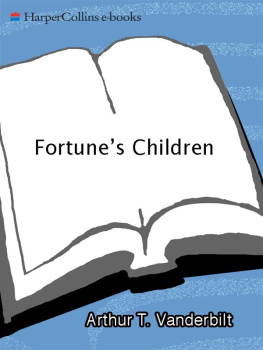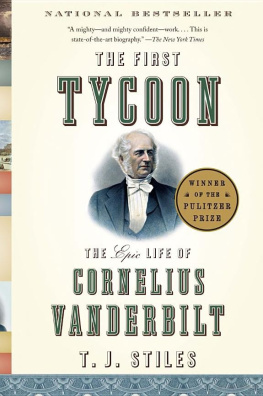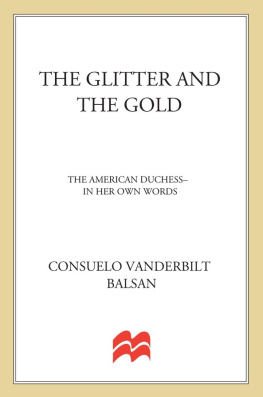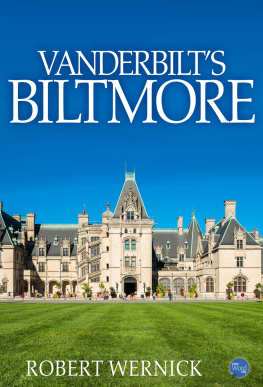
CONTENTS
The Fall of the House of VANDERBILT

A hardcover edition of this book was published in 1989 by William Morrow.
FORTUNES CHILDREN . Coyright 1989 by Arthur T. Vanderbilt II. All rights reserved under International and Pan-American Copyright Conventions. By payment of the required fees, you have been granted the non-exclusive, non-transferable right to access and read the text of this ebook on-screen. No part of this text may be reproduced, transmitted, down-loaded, decompiled, reverse engineered, or stored in or introduced into any information storage and retrieval system, in any form or by any means, whether electronic or mechanical, now known or hereinafter invented, without the express written permission of HarperCollins ebooks.
First Quill edition published 1991.
FIRST WILLIAM MORROW PAPERBACK EDITION PUBLISHED 2013.
Library of Congress Cataloging-in-Publication Data
Vanderbilt, Arthur T.
Fortunes Children : the fall of the house of Vanderbilt / Arthur T. Vanderbilt II.
p. cm.
ISBN 0-688-10386-3
1. Vanderbilt family. 2. United States-Biography. 3. Upper classesUnited States- Biography. 4. Wealth-United States-History. I. Title.
CT274.V35 1989
973.08621dc20
[B]
89-32421
CIP
ISBN 978-0-06-222406-4
13 14 15 16 17 OV/RRD 10 9 8 7 6 5 4 3 2 1
EPub Edition APRIL 2013 ISBN: 97800062288370

I magine waking up one morning to learn you had won the lottery. You are informed that the jackpot is $10 billion. You, the sole winner, have become the richest person in the world! The lottery officials tell you that you will receive all of the prize money in one lump sum, tax free, that morning. As a condition of receiving the money, you must never give away any of it to charity.
A close approximation of this unlikely event occurred an astonishing number of times during the Gilded Age, that heady time from the end of the Civil War to the turn of the century, the height of the Industrial Revolution in the United States, when great fortunes were made and spent overnight in a way that had never been seen before and will probably never be seen again.
The nations first great industrial fortune was won by the Vanderbilt family, and for a while this family could claim the title of the richest in the world. Subsequent fortunes surpassed it, but by then great wealth was decried. The unique opportunity that confronted the members of this particular family was the freedom to use their fortune just as they damned pleased, to create whatever reality they wanted, to give free rein to their every impulse without any sense of the social responsibilities that great wealth confers.
For the Vanderbilts lived in a day when flaunting ones money was not only accepted but celebrated. What may have started as playacting, as dressing up as dukes and princesses for fancy dress balls in fairytale palaces, soon developed into a firm conviction that they were indeed the new American nobility.
The bits and pieces of history that chronicle the four-generation saga of the Vanderbilt family are scattered everywhere like a broken string of pearls: in wills and court transcripts, letters, memoirs, journals, newspaper clippings, magazines, scrapbooks, photographs, and auction catalogs. But nowhere is that curious combination of magnificence and absurdity that was the Gilded Age more palpable than in the great country homes that still stand today as monuments to their dreams and fantasies: Idlehour, Marble House, The Breakers, Biltmore, Florham. These country estates were not just bigger or more ornate than other millionaires mansions. They rivaled the most magnificent country houses of England and the chteaus of France that had been passed down to titled descendants, generation to generation, since the Middle Ages. They were built to become precisely the American equivalent of these Old World palaces, great ancestral homes that would proclaim for centuries, for all time, the prominence of the Vanderbilts.
But it did not work out that way. Far from becoming ancestral homes, these monuments to limitless wealth, built for eternity, were hardly used for a lifetime. None was occupied by the next generation.
These great estates were but the familys country retreats, built after the Vanderbilts had achieved social prominence. Their main residences on Fifth Avenue in New York City were designed to so startle the world with their size and splendor that they would secure the familys preeminent position of social leadership. Dominating the prime real estate of what was even then one of the greatest cities of the world, the ten Vanderbilt mansions that lined Fifth Avenue were examples of epic extravagance. Yet these homes, too, failed to become the family seats their builders had envisioned. One by one, the Vanderbilt mansions on Fifth Avenue fell to the wreckers ball, their contents to the auctioneers gavel. The first of these Fifth Avenue mansions was completed in 1883, the first was demolished in 1914, and by 1947 every one had been broken to rubble.
This fabled golden era, this special world of luxury and privilege that the Vanderbilts created, lasted but a brief moment. Within thirty years after the death of Commodore Vanderbilt in 1877, no member of his family was among the richest people in the United States, having been supplanted by such new titans as Rockefeller, Carnegie, Frick, and Ford. Forty-eight years after his death, one of his direct descendants died penniless. Within seventy years of his death, the last of the great Vanderbilt mansions on Fifth Avenue had made way for modern office buildings. When 120 of the Commodores descendants gathered at Vanderbilt University in 1973 for the first family reunion, there was not a millionaire among them.
What had happened? What had gone wrong with the Vanderbilts plans to found a family dynasty? There is no easy answer. The ratification in 1913 of the Sixteenth Amendment to the Constitution, which gave Congress the power to tax incomes; rising property taxes; the imposition of estate taxes; the Depression; the fecundity of a family: All splintered the fortune. But taxes, depressions, and reproduction had posed no burden to the establishment of other family dynasties founded in the same era. The most recent listing in the Forbes Four Hundred of the richest people in the United States includes three Fords, with combined fortunes of over $1.5 billion; five Rockefellers holding net assets of over $3 billion, with another $2 billion spread among the rest of the family; and twenty Du Ponts, worth a total of $5 billion, in addition to another $2 billion held by other family members.
What happened to the richest family in the world is a remarkable story that no novelist would dare invent. What began as that peculiarly American dream of rags to richesin this case, the dream of a Staten Island water rat who turned his ambition and energy, his frugality and hard work into an astounding fortunebecame for the Commodores descendants an unusual nightmare as they discovered what they could do with the money and what the money could do to them. If ever Scott Fitzgerald needed evidence to substantiate his aphorism that the very richare different from you and me, it was here in spades in this portrait gallery of extravagant crazies that is the unique saga of the Vanderbilt family.









